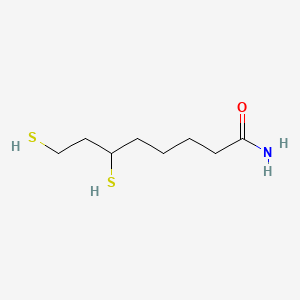| MeSH term | MeSH ID | Detail |
|---|---|---|
| Parkinsonian Disorders | D020734 | 20 associated lipids |
Dihydrolipoamide
Dihydrolipoamide is a lipid of Fatty Acyls (FA) class. Dihydrolipoamide is associated with abnormalities such as Wiskott-Aldrich Syndrome. The involved functions are known as Citric Acid Cycle, Electron Transport, NADH oxidation, Oxidation and Oxidants. Dihydrolipoamide often locates in Mitochondria, Mitochondrial matrix and Chloroplasts. The associated genes with Dihydrolipoamide are Mutant Proteins, Recombinant Proteins, mycothione reductase, Genes, Mitochondrial and alanylproline.
Cross Reference
Introduction
To understand associated biological information of Dihydrolipoamide, we collected biological information of abnormalities, associated pathways, cellular/molecular locations, biological functions, related genes/proteins, lipids and common seen animal/experimental models with organized paragraphs from literatures.
What diseases are associated with Dihydrolipoamide?
Dihydrolipoamide is suspected in and other diseases in descending order of the highest number of associated sentences.
Related references are mostly published in these journals:
| Disease | Cross reference | Weighted score | Related literature |
|---|
Possible diseases from mapped MeSH terms on references
We collected disease MeSH terms mapped to the references associated with Dihydrolipoamide
PubChem Associated disorders and diseases
What pathways are associated with Dihydrolipoamide
There are no associated biomedical information in the current reference collection.
PubChem Biomolecular Interactions and Pathways
Link to PubChem Biomolecular Interactions and PathwaysWhat cellular locations are associated with Dihydrolipoamide?
Visualization in cellular structure
Associated locations are in red color. Not associated locations are in black.
Related references are published most in these journals:
| Location | Cross reference | Weighted score | Related literatures |
|---|
What functions are associated with Dihydrolipoamide?
Related references are published most in these journals:
| Function | Cross reference | Weighted score | Related literatures |
|---|
What lipids are associated with Dihydrolipoamide?
There are no associated biomedical information in the current reference collection.
What genes are associated with Dihydrolipoamide?
Related references are published most in these journals:
| Gene | Cross reference | Weighted score | Related literatures |
|---|
What common seen animal models are associated with Dihydrolipoamide?
There are no associated biomedical information in the current reference collection.
NCBI Entrez Crosslinks
All references with Dihydrolipoamide
Download all related citations| Authors | Title | Published | Journal | PubMed Link |
|---|---|---|---|---|
| Karan R et al. | Function and biotechnology of extremophilic enzymes in low water activity. | 2012 | Aquat Biosyst | pmid:22480329 |
| Sharma A et al. | Interactomic and pharmacological insights on human sirt-1. | 2012 | Front Pharmacol | pmid:22470339 |
| Nam MH et al. | Comparative proteomic analysis of early salt stress-responsive proteins in roots of SnRK2 transgenic rice. | 2012 | Proteome Sci | pmid:22462395 |
| Redanz S et al. | A five-species transcriptome array for oral mixed-biofilm studies. | 2011 | PLoS ONE | pmid:22194794 |
| Garbeva P et al. | No apparent costs for facultative antibiotic production by the soil bacterium Pseudomonas fluorescens Pf0-1. | 2011 | PLoS ONE | pmid:22110622 |
| Schmidt MC et al. | Efficient α, β-motif finder for identification of phenotype-related functional modules. | 2011 | BMC Bioinformatics | pmid:22078292 |
| Picciocchi A et al. | Role of putative second transmembrane region of Nox2 protein in the structural stability and electron transfer of the phagocytic NADPH oxidase. | 2011 | J. Biol. Chem. | pmid:21659519 |
| Vanguilder HD and Freeman WM | The hippocampal neuroproteome with aging and cognitive decline: past progress and future directions. | 2011 | Front Aging Neurosci | pmid:21647399 |
| Barbieri E et al. | Morphofunctional and Biochemical Approaches for Studying Mitochondrial Changes during Myoblasts Differentiation. | 2011 | J Aging Res | pmid:21629710 |
| Kehr S et al. | Protein S-glutathionylation in malaria parasites. | 2011 | Antioxid. Redox Signal. | pmid:21595565 |
| Harvey RM et al. | A variable region within the genome of Streptococcus pneumoniae contributes to strain-strain variation in virulence. | 2011 | PLoS ONE | pmid:21573186 |
| Brautigam CA et al. | Structural and thermodynamic basis for weak interactions between dihydrolipoamide dehydrogenase and subunit-binding domain of the branched-chain alpha-ketoacid dehydrogenase complex. | 2011 | J. Biol. Chem. | pmid:21543315 |
| Suetsugu-Maki R et al. | A complement receptor C5a antagonist regulates epithelial to mesenchymal transition and crystallin expression after lens cataract surgery in mice. | 2011 | Mol. Vis. | pmid:21541266 |
| Aranjuelo I et al. | Plant physiology and proteomics reveals the leaf response to drought in alfalfa (Medicago sativa L.). | 2011 | J. Exp. Bot. | pmid:20797998 |
| Deringer JR et al. | Immunoreactive Coxiella burnetii Nine Mile proteins separated by 2D electrophoresis and identified by tandem mass spectrometry. | 2011 | Microbiology (Reading, Engl.) | pmid:21030434 |
| Feeney MA et al. | Repurposing lipoic acid changes electron flow in two important metabolic pathways of Escherichia coli. | 2011 | Proc. Natl. Acad. Sci. U.S.A. | pmid:21521794 |
| Kumar A et al. | Redox homeostasis in mycobacteria: the key to tuberculosis control? | 2011 | Expert Rev Mol Med | pmid:22172201 |
| Roldán A et al. | Lipoamide dehydrogenase is essential for both bloodstream and procyclic Trypanosoma brucei. | 2011 | Mol. Microbiol. | pmid:21631607 |
| Natarajan P and Parani M | De novo assembly and transcriptome analysis of five major tissues of Jatropha curcas L. using GS FLX titanium platform of 454 pyrosequencing. | 2011 | BMC Genomics | pmid:21492485 |
| Miller JA et al. | 1,3-Dinitrobenzene-induced metabolic impairment through selective inactivation of the pyruvate dehydrogenase complex. | 2011 | Toxicol. Sci. | pmid:21551353 |
